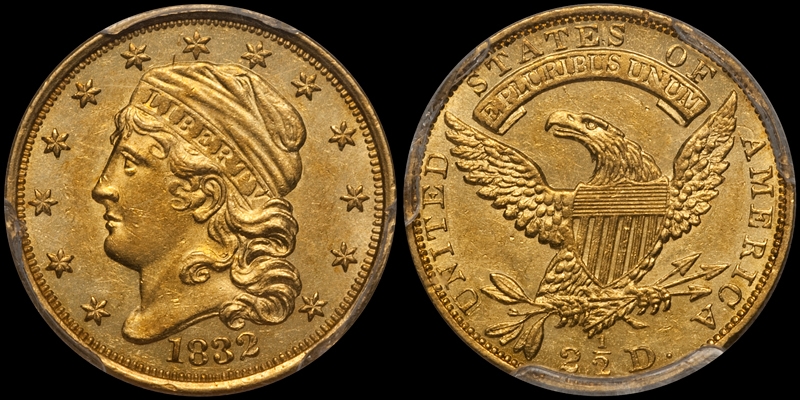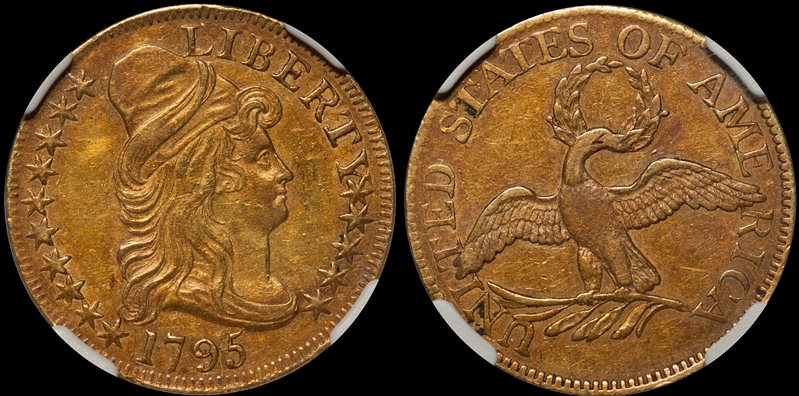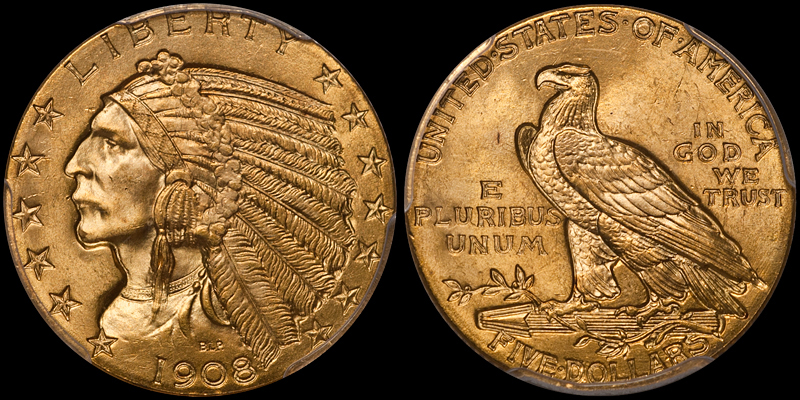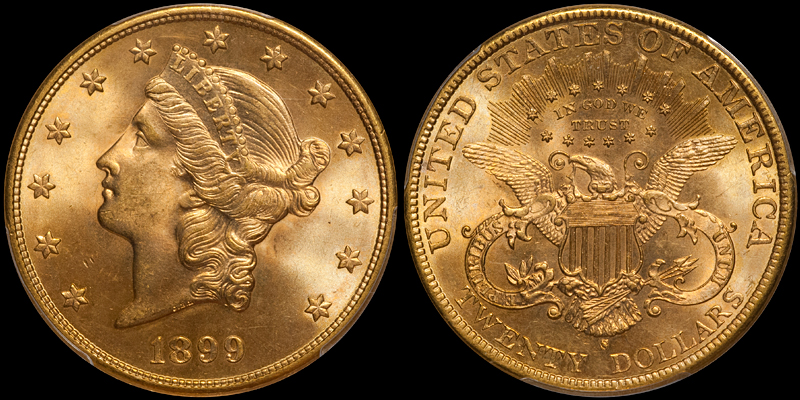The 36 Major Gold Types: A Collectors Guide
/Between 1795 and 1933 a total of 36 major gold types were issued for circulation. In my May 2017 article on collecting US gold by type I touched on these. In this follow-up, I’m going to discuss each type in more detail with suggestions on how and what to buy and some “alternative” dates to spice-up a type set. Please note that the collecting tips below are oriented towards medium to large budgets. As there are many very expensive types in this set, I would recommend a basic 8 coin type set for collectors with a more limited budget.
At the end of each type, I have rated the coins in regards to availability. The scale is as follows:
Level 1: Easy to locate in nearly any grade
Level 2: Easy to locate in lower grades, somewhat tough in Gem and higher
Level 3: A tough issue overall and a very scarce to rare one in higher grades
Level 4: Rare in all grades and very rare in higher grades
Level 5: The rarest of all US gold types
1. Type One Gold Dollar, 1849-1854
1849 Open Wreath $1.00 PCGS MS65 CAC
This is a very common type which can be easily located in grades up to MS66. For most collectors, a nice MS65 will suffice. I’d suggest an 1849 as the ideal date as it is a first-year issue and it tends to come well made. An interesting alternative might be a high grade (MS 63 or MS64) 1851-C or 1852-C, the most obtainable branch mint issues of this type.
RARITY LEVEL: 1
2. Type Two Gold Dollar, 1854-1856
1856-S $1.00 NGC MS64 CAC
The short-lived Type Two is by far the rarest of the three gold dollars in this set but it is more available in MS64 and MS65 grades than it was a generation or two ago. Most collectors will choose either an 1854 or an 1855 but why not consider an MS63 or MS64 1855-O or 1856-S if either of these comes available?
RARITY LEVEL: 2
3. Type Three Gold Dollar, 1856-1889
1868 $1.00 PCGS MS67 CAC
This type is also very common and even super high grade coins (MS67 and MS68) are available and not terrifically expensive. Most collectors choose a common date from the 1880’s to represent this type. I’d suggest a rarer date from the 1870’s in MS65 or MS66 as a more interesting alternative.
RARITY LEVEL: 1
4. Capped Bust Right No Stars Obverse Quarter Eagle, 1796 only
1796 $2.50 No Stars Obverse, courtesy of PCGS CoinFacts
This is one of the really tough US gold types and just 963 were struck. Many surviving No Stars quarter eagles are damaged (avoid these!!) and problem-free collector grade pieces are exceptionally hard to locate. You are going to have a very tough time with this type, even if you are a well-connected, wealthy collector so my best advice is that if you ever see the right coin and the price isn’t stupid, go for it.
RARITY LEVEL: 5
5. Capped Bust Right With Stars Quarter Eagle, 1796-1807
1806/5 7x6 Stars PCGS AU55 CAC
For most collectors, this is the oldest type of quarter eagle which they will include in their set. The three dates from the 18th century (1796 Stars, 1797, and 1798) are quite rare while the five dates from the early 19th century are somewhat more available. The best date for the type collector is the 1807 which is available in AU and lower Uncirculated grades. A nice alternative is a scarcer date such as the 1805 or 1806/4. Problem coins abound; try and be patient and use an expert’s guidance.
RARITY LEVEL: 3
6. Capped Bust Left Quarter Eagle, 1808 only
1808 $2.50 PCGS AU53 CAC
This is the second one-year only type of quarter eagle and it, too is a really rare coin. Just 2,710 were made and many survivors are damaged. I’d guess that there are just 20-30 pretty nice to nice ones known and most are tied-up in long-term collections. This is going to be one of the hardest types for the advanced collector to locate and I suggest being prepared to stretch for a nice one if and when it comes available.
RARITY LEVEL: 4+/5
7. Capped Head Left Large Size Quarter Eagle, 1821-1827
1825 $2.50 PCGS MS61 CAC
This type was struck for just five years. The most available dates are the 1825 and 1827 and even these are not easy to locate. This type didn’t see much circulation so it is not often seen in the middle circulated grades (Fine to Extremely Fine) and, thus, is not often available as “affordable” coins. The ultra-high grade type collector is going to find this type very difficult to locate as well. There are very few Gem (or near-Gem) examples known.
RARITY LEVEL: 3+/4
8. Capped Head Left Reduced Size Quarter Eagle, 1829-1834
1832 $2.50 PCGS 62
Another short-lived type but only one issue (the 1834) is very rare. The other dates are somewhat available and there are nice Uncirculated pieces around which are more than suitable for type purposes. Most type collectors select the 1829 as their date of choice; I would suggest considering the slightly rarer 1832 or 1833.
RARITY LEVEL: 3
9. Classic Head Quarter Eagle, 1834-1838
1839-D $2.50 PCGS MS62
This is an interesting though short-lived type with one-year branch mint options (1839-D and 1839-O) as well as a two-year run from Charlotte. The Philadelphia issues are mostly common and easily located in circulated or the lower Uncirculated. Properly graded Gems are very rare. If it were my choice, I’d opt for a branch mint issue in the highest grade I could afford.
RARITY LEVEL: 2
10. Liberty Head Quarter Eagle, 1840-1907
1851-D $2.50 NGC MS65
The Liberty Head quarter eagle is one of the longest-lasting U.S. gold types. Dates range from ultra-common to very rare and there are many date collectors and mint collectors focused on this type. Common date Gems are very reasonably priced and coins grading up to MS67 are fairly readily available. Pre-1895 issues are generally much scarcer and I would focus on a Gem lower mintage (or a date from the 1850’s/1860’s) as a type coin.
RARITY LEVEL: 1
11. Indian Head Quarter Eagle, 1908-1929
1911 $2.50 PCGS MS65 CAC
This 15-coin set is easy to complete and is popular with date collectors as a result. It is an easy type to locate up through MS65 and uber-Gem collectors can reasonably expect to add an MS66 to their set. I would suggest a better date like a 1909-1911 which sells for just a small premium in MS63 or MS64 over common dates.
RARITY LEVEL: 1
12. Three Dollars, 1854-1889
1885 $3.00 PCGS MS64
The 1854 is actually a distinct one-year type coin (Small Letters) but is not recognized as such. This interesting, odd denomination is currently out of favor which means that a really nice Uncirculated common date can be purchased for $4,000-6,000. I’d recommend a low-mintage date from the early 1880’s as a type coin. High-grade pieces (up through MS67) are available for certain years.
RARITY LEVEL: 1
13. Four Dollars (Stella), 1879-1880
1879 Flowing Hair $4.00 Stella, courtesy of CoinFacts
While generally included in advanced U.S. gold type collections, these Proof-only issues are technically patterns. The most available is the 1879 Flowing Hair of which 500 or so were produced. Impaired Proofs exist; these are generally ugly and always expensive. For most collectors, the Stella is an interesting but unnecessary type. High-end collectors who want a Gem should be able to locate one.
RARITY LEVEL: 3+/4
14. Capped Bust Right Half Eagle, Small Eagle Reverse, 1795-1798
1795 Small Eagle $5.00 NGC AU55+
This is among my favorite U.S. gold types. Ironically the neatest single issue (the first-year 1795) is also the most available with a comparatively high mintage of 8,707. The 1796/5 is rarer (as are the two 1797 varieties) but I would suggest a nice 1795 for this type. There are hundreds known but choice, wholesome pieces are not easy to locate.
RARITY LEVEL: 3/3+
15. Capped Bust Right Half Eagle, Heraldic Eagle Reverse, 1795-1807
1798 Large 8, 13 Stars $5.00 PCGS MS62 CAC
This is among the most plentiful early American gold types and it is available in a variety of price ranges. For the collector on a medium budget, this will likely be the earliest gold type he will purchase. High-budget type collectors can expect an MS64 or even an MS65. I love the idea of adding an 18th century issue (1798 or 1799) as opposed to one of the more available 1800-1807 dates.
RARITY LEVEL: 2/2+
16. Capped Bust Left Half Eagle, 1807-1812
1807 $5.00 NGC MS62
This short-lived type is available in a wide range of grades and price points. The average budget should shoot for a nice coin while the high budget collector can reasonably expect an MS64 or even an MS65. I like the first-year 1807 as an interesting date but any of these issues (except for some rare types) are good choices for a type set.
RARITY LEVEL: 2/2+
17. Capped Head Left Large Size Half Eagle, 1813-1829
1813 $5.00 PCGS MS64
The rarity range for this type encompasses a few fairly available dates (1813, 1814/3, 1818, and 1820) and many rare to extremely rare issues. Most collectors focus on the 1813 as it is far more available than any of the other dates. I would suggest opting for a scarce but still semi-affordable date in slightly lower grades. High-grade examples of this type exist but they are expensive.
RARITY LEVEL: 2/2+ for the 1813, 1814/3, 1818, and 1820; 3+ to 5 for most other dates of this type
18. Capped Head Left Small Size Half Eagle, 1829-1834
1830 Capped Head Left Small Size $5.00, courtesy of PCGS CoinFacts
This type was heavily melted in 1834 after the weight of this denomination was reduced and this type became worth more than face value. All dates are rare and many dates are virtually unknown in affordable collector grades. This is clearly one of the most expensive collectible types in this series and Gems are available but cost in the low six figures.
RARITY LEVEL: 3+/4
19. Classic Head Half Eagle, 1834-1839
1838-C $5.00 NGC MS60
Classic Head half eagles are plentiful in circulated grades and can be located in the lower Uncirculated grades with little effort. Gems exist but are very rare. The two most interesting issues are the one-year 1838-C and 1838-D but these aren’t good choices for type coins as they aren’t often found above EF/AU grades.
RARITY LEVEL: 2
20. Liberty Head No Motto (Obverse Mintmark) Half Eagle, 1839 only
1839-D $5.00 PCGS AU58
PCGS doesn’t recognize this as a distinct type but I think it should be and since this is my article, it is being recognized. Three mints produced this type: Philadelphia, Charlotte, and Dahlonega. The Philadelphia is the most common while the two mintmarked issues are scarce. If possible, choose a nice 1839-C or 1839-D to represent this type.
RARITY LEVEL: 2/3
21. Liberty Head No Motto (Reverse Mintmark) Half Eagle, 1839-1866
1860-C $5.00 NGC MS64 CAC
This type was produced at the Philadelphia, Charlotte, Dahlonega, New Orleans, and San Francisco mints. Individual issues range from very common to very rare. and the No Motto series has many date and mintmark specialists. Any date of this design is scarce to rare in MS63 and Gems are extremely rare. I would select an interesting mintmarked coin as my type representative.
RARITY LEVEL: 2
22. Liberty Head With Motto Half Eagle, 1866-1908
1899-S $5.00 PCGS MS65 CAC
Most of the pre-1880 dates of this type are scarce to rare while many of the post-1880 dates are very common. A few dates exist in MS65 and higher grades and these are generally the coins which high-end collectors seek. Common MS65 and MS66 With Motto half eagles seem like good buys now at current levels. I might consider a rarer date in MS62 to MS64 as my type coin if the right piece became available.
RARITY LEVEL: 1
23. Indian Head Half Eagle, 1908-1929
1908 Indian $5.00 PCGS MS65 CAC
This is one of just two American gold coins ever struck with an incuse or sunken design. It is a common type in MS63 and MS64 and even MS65 examples can be found with some effort. Ultra-Gem MS66 and finer pieces exist but are rare. I’d suggest paying a small premium and getting a scarcer date.
RARITY LEVEL: 1
24. Capped Bust Right Small Eagle Ten Dollars, 1795-1797
1795 $10.00, courtesy of PCGS CoinFacts
As with the same type half eagle (see above), the 1795 is the favorite date for type purposes as it is the most available issue and it is an important first-year-of-type. There are more 1795 eagles in existence than one might surmise but few are choice and original. Any piece with natural color and choice surfaces commands a strong premium.
RARITY LEVEL: 3/3+
25. Capped Bust Right Large Eagle Ten Dollars, 1797-1804
1799 Large Stars $10.00 PCGS MS63
This type was made for seven years and then the entire denomination was scrapped until 1838. I like the 1799 best as a type date given its 18th century issuance but the 1801 and 1803 are interesting issues as well. This type is not rare but locating really nice individual coins has become very challenging. High grade type sets can expect coins in grades as lofty as MS63 to MS64; Gems are very rare.
RARITY LEVEL: 2+/3
26. Liberty Head No Motto Covered Ear Eagle, 1838-1839
1839/8 $10.00 PCGS AU58
While not always recognized as a distinct type, the eagles of 1838 and early 1839 are decidedly different than their counterparts from later in 1839 and on through 1866. As a type representative, I like the first-year 1838. It is scarce in all grades and very rare in Uncirculated and type collectors will be competing with Liberty Head eagle date collectors for nice examples.
RARITY LEVEL: 2/2+
27. Liberty Head No Motto Eagle, 1839-1866
1847-O $10.00 NGC MS61
This type contains many very scarce dates but there are also common issues which are perfect for type sets. All dates become scarce in grades above MS62 and Gem No Motto eagles are extremely rare. How about including a higher grade 1847-O or 1851-O to make this type more interesting?
RARITY LEVEL: 2 (higher than this is MS63 and above)
28. Liberty Head With Motto Eagle, 1866-1907
1879-O $10.00 PCGS AU58
Most pre-1880 With Motto eagles are scarce and many dates are either unknown or are exceedingly rare in Uncirculated. This type is easy to locate in MS65 and higher grades, however, due to a number of common Philadelphia and San Francisco issues from the post-1880 era.
RARITY LEVEL: 1
29. Indian Head No Motto Eagle, 1907-1908
1907 No Periods $10.00 PCGS AU55 CAC
PCGS recognizes the Wire Edge and Rolled Edge issues of 1907 as separate types; I do not. I simply divide the Indian Head eagles into two designs: No Motto and With Motto. The 1907 No Periods makes an interesting choice for this issue due to its first-year status. It is available in grades up through MS66.
RARITY LEVEL: 1
30. Indian Head With Motto Eagle, 1908-1933
1910-D $10.00 PCGS MS66 CAC
I regard this as the most beautiful American gold coin struck for regular circulation, and high-grade pieces are extremely attractive. Most collectors select the common 1926 or 1932 for type but I would choose a slightly less available early date. This type is available in grades up through MS66.
RARITY LEVEL: 1
31. Liberty Head Double Eagle Type One, 1850-1866
1850 $20.00 PCGS MS64+ CAC
The availability of this type in higher grades has been changed by the discovery of thousands of higher grade pieces in shipwrecks. Today, the type collector can easily locate an MS65 or even an MS66 1857-S from the S.S. Central America. Non-shipwreck coins are rare in MS63 and very rare above this.
RARITY LEVEL: 1
32. Liberty Head Double Eagle Type Two, 1866-1876
1868-S $20.00 NGC MS62
Production of double eagles at the legendary Carson City mint commences with this type but for high-grade collectors, it is more feasible to select one of the more available Philadelphia or San Francisco issues from the 1873-1876 era. This type remains extremely rare in real MS65 and above; most collectors look for a piece in the MS62 to MS63 range.
RARITY LEVEL: 1 (overall availability); 4 (availability in MS65 and higher)
33. Liberty Head Double Eagle Type Three, 1877-1907
1899-S $20.00 PCGS MS65
This type contains some rarities but it also contains some extremely common issues which can be easily located in MS65 and even MS66. The pre-1900 dates tend to be harder to locate but a few of these can be found in MS65.
RARITY LEVEL: 1
34. St. Gaudens Double Eagle High Relief, 1907
MCMVII (1907) $20.00 Wire Rim, NGC MS65
While arguably one of the more overvalued US gold coins, High Reliefs are beautiful and very popular. The type collector should be able to easily locate one in nearly any grade according to his budget.
RARITY LEVEL: 1
35. St. Gaudens Double Eagle No Motto, 1907-1908
the more common 1908 No Motto $20.00, NGC MS67 CAC
This two-year type is very common. For a type set, I recommend selecting the first-year-of-issue 1907 as it is a scarcer and more interesting date than the very common 1908 No Motto.
RARITY LEVEL: 1
36. St. Gaudens Double Eagle With Motto, 1908-1933
1920 $20.00 PCGS MS64 CAC
Here is another very common type which can be easily found in grades up though MS66 to MS67. I would select a slightly better date as my type representative instead of a common 1924/1926/1927/1928.
RARITY LEVEL: 1
So there you have it: 36 major types of US gold coinage (PCGS lists 38 in their set) ranging from very common to extremely rare. This is an ambitious but ultimately completable set with no impossible “stoppers.” What I like about this set is that it encompasses coins from the 1790’s and pairs them with the now-familiar designs of the 20th century.
Are you thinking of assembling a complete 36 issue US gold type set? I have helped numerous collectors with this set and have completed some of the finest ones ever assembled. Contact Doug Winter at (214) 675-9897 for more information.





















































